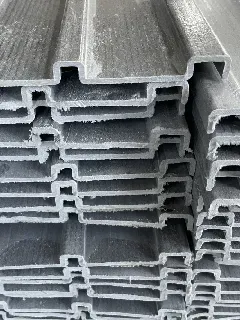loading...
- No. 9, Xingyuan South Street, Dongwaihuan Road, Zaoqiang County, Hengshui, Hebei, China
- admin@zjcomposites.com
- +86 15097380338
- Welcome to visit our website!
pressure tank
Understanding Pressure Tanks Functions, Types, and Applications
Pressure tanks are essential components in a wide range of industries, providing crucial functionality in the management and storage of gases and liquids. Their ability to withstand high pressure makes them vital in maintaining system efficiency and safety. In this article, we will explore the functions of pressure tanks, the different types available, and their various applications across multiple sectors.
What is a Pressure Tank?
A pressure tank is a vessel designed to hold gases or liquids at a pressure substantially different from the ambient pressure. These tanks are engineered to prevent excessive pressure buildup while ensuring safe storage and usage of materials that can be hazardous if not properly contained. They are often constructed from robust materials such as steel or composite materials, designed to withstand the specific pressures they will encounter in operation.
Functions of Pressure Tanks
The primary function of a pressure tank is to store fluids under pressure. However, their capabilities extend beyond mere storage
1. Pressure Regulation Pressure tanks help maintain a consistent pressure level in a system. This is especially important in applications such as water supply systems, where fluctuations in pressure can lead to system failures. 2. Hydraulic Accumulator In hydraulic systems, pressure tanks act as accumulators, storing hydraulic fluid under pressure. This allows for quick response times and helps absorb pressure spikes, which can otherwise damage equipment.
3. Separation of Phases In certain applications, pressure tanks are used to separate different phases of a mixture. For instance, in oil and gas industries, they may be employed to hold oil, gas, and water at different pressures to ensure efficient extraction and transport.
4. Support for Pump Systems In water well systems, pressure tanks support pump operation by providing a buffer between the pump and the distribution system. This reduces the frequency of pump cycling, leading to longer lifespan and energy efficiency.
5. Safety By containing fluids and gases under controlled pressure, these tanks prevent the release of harmful substances into the environment, thereby enhancing workplace safety.
Types of Pressure Tanks
Pressure tanks come in various designs, each suited for specific applications
1. Bladder Pressure Tanks These tanks feature a flexible diaphragm (bladder) that separates the water from the air. As the tank fills, the bladder expands, maintaining pressure in the system. They are commonly used in residential water systems.
pressure tank

2. Diaphragm Pressure Tanks Similar to bladder tanks, diaphragm pressure tanks use a rubber diaphragm to separate air and liquid. They are designed for more compact spaces and are often used in irrigation systems.
3. ASME Pressure Vessels These tanks are designed to meet the standards set by the American Society of Mechanical Engineers (ASME) for high-pressure applications. They are typically used in commercial and industrial settings for the storage of gases and liquids.
4. Vertical and Horizontal Tanks Pressure tanks can be oriented vertically or horizontally based on the space available and the application requirements. Vertical tanks are often used in small installations, while horizontal tanks are favored for larger volumes.
Applications of Pressure Tanks
Pressure tanks find applications in numerous fields, showcasing their versatility
1. Water Supply Systems In residential settings, they store pressurized water to supply homes, ensuring that the water remains available with consistent pressure for activities such as showering and washing.
2. Agriculture In irrigation systems, pressure tanks regulate water delivery, ensuring that crops receive the necessary hydration without overwhelming them with excess pressure.
3. Oil and Gas These tanks are crucial in the exploration and extraction of hydrocarbons, containing high-pressure gases and liquids during transport and processing.
4. HVAC Systems In heating, ventilation, and air conditioning, pressure tanks help manage fluid pressure in closed-loop systems, improving energy efficiency and system longevity.
5. Manufacturing In industrial processes, pressure tanks are utilized for holding raw materials, ensuring that production lines maintain optimal operating conditions.
Conclusion
Pressure tanks play a critical role in various industries, ensuring the safe and efficient management of fluids under pressure. With a selection of types tailored to specific applications, these tanks enhance system performance, provide safety, and contribute to sustainability. As industrial processes continue to evolve, the importance of understanding and employing appropriate pressure tanks cannot be overstated. Whether in water supply, agriculture, oil and gas, or manufacturing, pressure tanks are indispensable in maintaining operational integrity and safety.
-
GRP Structures: The Future of Lightweight, High-Performance EngineeringNewsJun.20,2025
-
FRP Water Tank: High-Performance Storage for Corrosive and Clean Water SystemsNewsJun.20,2025
-
FRP Square Tube: The New Industry Standard for Chemical and Structural ApplicationsNewsJun.20,2025
-
FRP Pultruded Profiles: The Ultimate Choice for Lightweight Structural StrengthNewsJun.20,2025
-
FRP Handrails: The Safer, Smarter, and Stronger Choice for Modern InfrastructureNewsJun.20,2025
-
FRP Grating: The Smart Solution for Durable, Lightweight Industrial FlooringNewsJun.20,2025
-
Why Choose a Galvanized Water Tank for Your Storage NeedsNewsMay.21,2025
